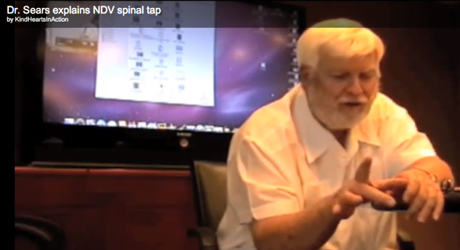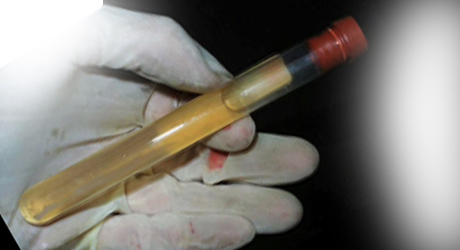UPDATE: A study of the NDV spinal tap, to treat dogs who have reached the neurologic stage of the disease had been conducted at Kansas State University from 2014 to 2016. After some promising results in early cases, Dr. Ken Harkin ultimately concluded that the NDV spinal tap — injecting Newcastle’s Disease Vaccine directly into the spinal canal — did not help in the recovery of distemper dogs. But he also believes we give up on these dogs too early. The disease can and does go into remission on its own, so dogs can survive neurologic distemper with enough nursing care. So, you should also look at these stories as examples of how it is possible for dogs in the neurologic stage of distemper to regain a decent quality of life.
Click here for examples of dogs successfully treated with the NDV spinal tap
NEUROLOGIC DISTEMPER all forms
(ODE – Old Dog Encephalitis.)
This medical protocol covers neurologic forms of distemper which include chorea, seizures, progressive paralysis, blindness. This medical protocol pertains to dogs of all ages who ARE infected with the neurologic forms of distemper. Presence of antidistemper antibodies in the CSF is totally diagnostic of this problem. The neurological symptoms may appear in some dogs as soon as two weeks and in others as long as eight years after infection. In the past, any of these symptoms as noted above resulted in progressive and imminent death.
A new treatment has been developed that has been totally successful in two dogs with all the above symptoms : Both dogs have been positively diagnosed with antidistemper antibodies in the CSF by Antech labs in Calif.
As of Aug 6, 2008, two dogs are alive with minimal signs of the distemper neurologic secondary form. One with seizures the other with blindness and paralysis. Both are alive and doing well 10 months after initial treatment {Photos of these dogs are available and copies or the original lab work confirming neurologic distemper are available.
So far these two dogs have remained symptom free for 10 months. This treatment does not replace lost neural tracts. Neural recovery takes place as new tracts are formed in the brain. I have only used this on two dogs to date. Any further use of this procedure is purely experimental. This medical protocol will be updated and or revised as more information becomes available.
UPDATE JUNE 2009: Several more successful cases have been reported from Texas, Georgia, Florida and California.
Newcastle’s Disease Virus (NDV) is the inducer that will eliminate intracellular distemper virus in the brain, also eliminate the immune disorder causing neurologic damage in the canine. ( C-4 cell damage) I have used the La Sota strain only because it has been available. 1000 dose bottles with 6 cc of dilutent is your inducer. This material can be purchased at any agricultural store that deals with poultry.
Medical procedure protocol for spinal tap treatment
1. Place an IV catheter.
2. Anesthetize the dog as for surgery.
3. Prep for surgery at the foramen magnum.
4. Spinal tap at the Foramen Magnum.
5. Remove 0.1 cc to 1.0 cc of spinal fluid based on the size of the dog.
6. Send the spinal fluid to a lab for testing for anti-distemper antibodies. Antech Labs.
7. Inject using the same placed needle from 0.1 to 0.5 cc of NDV depending on size of the dog directly into the spinal canal and flush the needle with ½ to 1 cc of saline.
8. Treat the dog for shock with fluids after giving this injection.
[Note: A video on how to perform this procedure is available at https://kindheartsinaction.com/2009/12/17/dr-sears-describes-a-spinal-tap/]
Send saved spinal fluid to Lab for Anti-Distemper Antibodies in the CSF. Any distemper antibody found is totally diagnostic for Neurologic Distemper.
Other tests to be deemed necessary by the attending veterinarian. Toxoplasmosis, immune cells, Infection, other causes of neuropathology, cancer.
NDV vaccine will initiate immune cytokines within the brain and spinal area. It will shut down the damaging immune response (active T-cells) as well as eliminate the offending Cerebral Intracellular Distemper virus within 24 hours.
Regenerative ability of the brain stem cells (Schwann cells or oligodendrocytes, and the replacement of myelin, stem cells) will allow for healing over a period of time and it will vary depending on the genetics of the dog and its ability to recover.
Control of the seizure activity at this time can be controlled with Phenobarb, Na Bromide and other seizure medications until all symptoms come under control and disappear. The time involved here depends on the severity of the damage and the ability and genetics of the animal to recover. This can be a long-term recovery.
This procedure does not replace damaged neurons, nor does it make new myelin or Schwann cells. It does stop the progression of the disease and turns off the damaging active T-cells. It eliminates the offending intracellular distemper viruses. Allows for the survival of infected dogs and stops the immunological process from which untreated dogs will expire. Long-term recovery depends on the genetics of the dogs and the ability of the stem cell system to replace oligodendrocytes and develop new neural pathways and replace damaged myelin.
The basic ideas for these procedures were first promulgated by Dr. John Adams of UCLA in the early 70s. His thoughts were that the distemper and measles viruses were homologous and that the ODE an MS were homologous, if not identical. It would be hoped that just one interested person would read this and continue the above research into MS. May Dr. Adams, a giant in virology, rest in peace.
Life long immunity to distemper is conferred with infection from distemper virus.
Therefore repeat vaccination is equivocal. Live Parvo virus is NOT recommended. Combination vaccines are not recommended. Single killed virus vaccines are recommended after a period of time. Usually one year. If questions arise as to immunity have titers run for any virus.
NDV once given to any dog establishes NDV antibody for which there is no need. It precludes the use of NDV in any particular dog in the future as the antibody will neutralize this virus and prevent its activity on the immune system.
Test for neurologic distemper is a CSF antidistemper antibody test by a lab. Any antibody present is diagnostic. A second test just as specific is an MRI of the brain and spinal cord. Deficits of myelin can be identified and is probable distemper, definite deymyelination. A third involves the death of the animal. Pathology check of the brain will show intracellular virus. All three are diagnostic.
IgG corporeal distemper antibodies do not cross the blood brain barrier. So, if antibodies are present in the spinal fluid then you have neurologic distemper. Conversely if you have antibodies in the CSF and not in the blood serum and have had no symptoms of overt distemper then you have a rare form of distemper probably caused by vaccine.
If anybody has any questions please feel free to contact me. E-Mail – antidistemper@aol.com A.W.Sears , DVM
UPDATE, JUNE 6, 2009: These are notes from a vet in Texas who used this treatment. Vets using this procedure are using ultrasound to ensure the needle does not cause any damage. “As far as how to position the head – there are two ways that I have come across. One is with the spine at the edge of the table and the neck flexed with the bridge of the nose perpendicular to the spine – the nose has to be parallel to the table. The other way is similar but the neck is flexed as far as possible – that is what worked for Hunter. The idea is to open the cisterna magnum as much as possible to allow access to the spinal fluid. The landmarks are the same- the cranial edge of C2 and the occipital protuberance (the bone on top of their head, which I like to call the “knowledge bump”).
UPDATE, JAN. 11, 2010: Improvement from neuro distemper is not fast as in systemic infection. It takes weeks. You should be on some form of antiseizure medication if seizures are a problem. Time is now your friend. Must replace the oligodendrocytes destroyed by the virus and once this happens new myelin is produced and symptoms begin to disappear. Takes time. Doc Sears
UPDATE, APRIL 7, 2010: I talked to an old friend vet in Calif today who treated a case neurolgically and had pain. He treated with Buprenorphine and said the dog was much more comfortable. And did well. I would suggest this as a post brain tap treatment to see if it helps with the pain. Buprenophine 0.005 – 0.03 mg/kg IV or IM or SQ . 2 to 4 times daily. Also comes under the names of Buprenex, Buprenor, or Tumgesic. Vets have access to this drug. Worth a try.
I’m hearing of a large group of dogs that are having problems with lock jaw after being treated intrathecally. Do not know the cause. But, most of these cases go on to die or be euthanized. I think this needs to be put into the protocol as an exception. I know of no way to help this situation at this time. Doc
Additional information, endorsed by Dr. Sears: “Also use valium orally or rectally. Between pain control and keeping them relaxed/sleeping for the first week, this helps them recover from the tap and seizures. For a 4 lb dog, we used 0.7ml up to three times a day of liquid valium–per treating vets tried both the cherry kid’s oral and the IV valium in her rectum. I was given pre-filled syringes of buprenorpnine for a week–in a big jar, and several days of pre-filled syringes of valium plus a prescription was called into my local pharmacy.”
Treatment at presentation of acute upper respiratory disease.
Tamiflu–Turns out some of these other viruses are extremely sensitive to this medication. I would recommend that 1 mg/lb be given twice daily for at lease 7 days. Should block most of the viruses we are discussing.
Antibiotics.–All these viruses cause inflammation in the lungs. (flu causes hemorrhagic pneumonia) All leave a BACTERIAL SECONDARY PNEUMONIA. My recommendation is Penicillin -G and Baytril inj three times daily in older dogs 9 Mos or older for at least 10 days.
Penicillin -G and Chloromycetin (25 mg/lb) three times daily for 10 days in younger dogs. (Baytril causes joint problems in younger dogs)
Supportive fluids and feeding as necessary.
There is an effective test for these viruses developed and available through ANTECH. This is a throat swab that distinguishes the upper respiratory viruses and give a good diagnosis. Also for distemper there is still the transitional cell bladder test. Works great to diagnose acute distemper quickly.
There is a test for distemper antigen an intranasal swab that is done at the clinical level. Problem with this test is that it can and does go positive with vaccine distemper virus. So, it can and does give false positive tests for distemper and cause a misdiagnosis.
Bordetella is kennel cough. It is treated with cephalosporin antibiotics. It does not routinely cause pneumonia. Can be confused with the viral diseases. I DO NOT LIKE THIS CLASS OF ANTIBIOTICS FOR PNEUMONIA IN VIRAL DISEASES.
List of upper respirartory diseases that can and are confused with distemper
Parainfluenza
Adenovirus
Canine influenza H3N8
influenza H1N1
Mycoplasma
Corona virus
Herpes virus
Many bacterial pneumonias.
Treatment of secondary neurologic problems in dogs remains the same at this time. This problem is only seen in those dogs treated late in the disease or those that make a spontaneous recovery.
If you have any comments or recommendations please write to me and we can discuss them. I came to realize that a lot of the pneumonias that are reported are NOT distemper. Still need to be treated.
Fighting the distemper virus is only half of the battle. Here are some important notes from Dr. Sears.
You should also review this page on post-spinal tap issues. If your dog is still having trouble after the NDV spinal tap, check out our discussion board for tips and advice posted by other dog owners with difficult recoveries.




